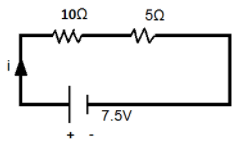
Answer
376.2k+ views
Hint: In order to solve this question, we are firstly going to find the equivalent resistance for the given circuit by telling whether the two resistances are in series combination or the parallel one. After that the total voltage of the circuit is taken along with equivalent resistance to find the electric current.
Formula used: The formula for the equivalent resistance of the resistors in parallel is given by the formula:
\[{R_{eq}} = {R_1} + {R_2}\]
The electric current in the circuit shown is given by the formula
\[i = \dfrac{V}{{{R_{eq}}}}\]
Where \[V\] is the voltage of the circuit as given.
Complete step by step answer:
The amount of the current passing through the resistor of resistance \[10\Omega \] will also pass through the resistor of the resistance \[5\Omega \]. Thus, this means that the two resistors are connected in series with each other.
We know that the formula for the equivalent resistance of the resistors in parallel is given by the formula:
\[{R_{eq}} = {R_1} + {R_2}\]
Therefore, their equivalent resistance is equal to
\[{R_{eq}} = 10\Omega + 5\Omega = 15\Omega \]
Thus, the electric current in the circuit shown is given by the formula
\[i = \dfrac{V}{{{R_{eq}}}}\]
Where, \[V\] is the voltage of the circuit as shown .
Thus, putting the values to get the electric current.
\[i = \dfrac{{7.5}}{{15}} = 0.5A\]
Note: It is important to note that in a circuit that consists of the resistors in series they have the same amount of the current passing through all the resistors and the voltage is different. While for the resistors in parallel, the current passing through all is different and the voltages are the same.
Formula used: The formula for the equivalent resistance of the resistors in parallel is given by the formula:
\[{R_{eq}} = {R_1} + {R_2}\]
The electric current in the circuit shown is given by the formula
\[i = \dfrac{V}{{{R_{eq}}}}\]
Where \[V\] is the voltage of the circuit as given.
Complete step by step answer:
The amount of the current passing through the resistor of resistance \[10\Omega \] will also pass through the resistor of the resistance \[5\Omega \]. Thus, this means that the two resistors are connected in series with each other.
We know that the formula for the equivalent resistance of the resistors in parallel is given by the formula:
\[{R_{eq}} = {R_1} + {R_2}\]
Therefore, their equivalent resistance is equal to
\[{R_{eq}} = 10\Omega + 5\Omega = 15\Omega \]
Thus, the electric current in the circuit shown is given by the formula
\[i = \dfrac{V}{{{R_{eq}}}}\]
Where, \[V\] is the voltage of the circuit as shown .
Thus, putting the values to get the electric current.
\[i = \dfrac{{7.5}}{{15}} = 0.5A\]
Note: It is important to note that in a circuit that consists of the resistors in series they have the same amount of the current passing through all the resistors and the voltage is different. While for the resistors in parallel, the current passing through all is different and the voltages are the same.
Recently Updated Pages
How many sigma and pi bonds are present in HCequiv class 11 chemistry CBSE

Mark and label the given geoinformation on the outline class 11 social science CBSE

When people say No pun intended what does that mea class 8 english CBSE

Name the states which share their boundary with Indias class 9 social science CBSE

Give an account of the Northern Plains of India class 9 social science CBSE

Change the following sentences into negative and interrogative class 10 english CBSE

Trending doubts
Fill the blanks with the suitable prepositions 1 The class 9 english CBSE

Which are the Top 10 Largest Countries of the World?

Give 10 examples for herbs , shrubs , climbers , creepers

Difference Between Plant Cell and Animal Cell

Difference between Prokaryotic cell and Eukaryotic class 11 biology CBSE

The Equation xxx + 2 is Satisfied when x is Equal to Class 10 Maths

Change the following sentences into negative and interrogative class 10 english CBSE

How do you graph the function fx 4x class 9 maths CBSE

Write a letter to the principal requesting him to grant class 10 english CBSE




